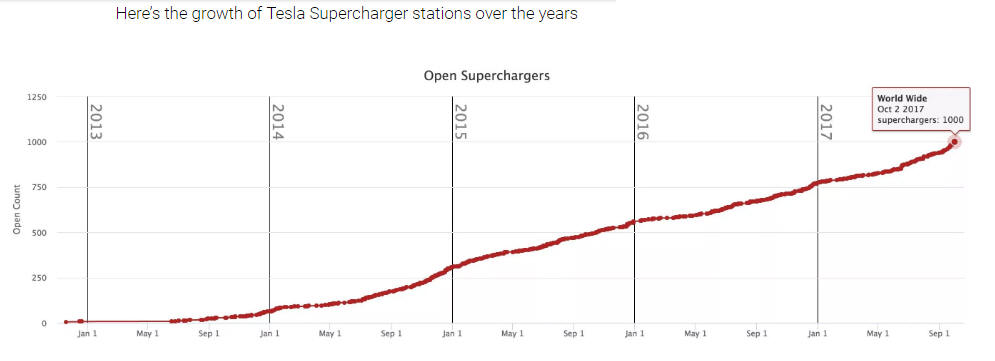The Tesla Supercharger network is a system of 480-volt DC fast-charging stations built by Tesla Inc. to allow longer journeys for their all-electric manufactured vehicles (Model S, 3 and X), through the quick charging of the vehicle's battery packs. Tesla is installing Superchargers in urban areas where city dwellers and out of town visitors can easily charge. These stations are placed at convenient locations like grocery stores, downtown districts, and shopping centers so charging fits seamlessly into your life. Tesla began building the network in 2012. In October 2014, there were 119 standard Tesla Supercharger stations operating in the United States, 76 in Europe, and 26 in Asia. Tesla began 2017 with 5,000 Superchargers around the world and as of September 2018, there were 11,041 Superchargers, with 1,344 stations globally. Most Superchargers are owned by Tesla, but some are owned by fleet operators to charge their Tesla cars, such as taxis.
Tesla’s Supercharger network
- 2013 - 6 Superchargers in California + 2 Superchargers on the US East Coast
- In October 2014, there were 119 standard Tesla Supercharger stations operating in the United States, 76 in Europe, and 26 in Asia
- The number of Supercharger stations grew to 280 by the end of 2014; 584 by the end of 2015; 623 as of April 2016; and about 875 by the end of 2016
- Tesla’s Supercharger network reached a milestone of 1,000 Supercharger stations worldwide in October 2017
- By December 2017, there were 1,045 Supercharger Locations worldwide with 5,000 Superchargers

- As of September 2018, there were 1,344 stations globally with 11,041 Superchargers
Tesla owners can plug in for about 30 minutes and grab a cup of coffee or a quick bite to eat while they charge. Each year, Model S and Model X owners receive 400 kWh of free Supercharger credit, enough to drive about 1,000 miles. These credits cover the long distance driving needs of most Model S and Model X owners, so road trips are completely free. Customers who travel beyond the annual credit pay a small fee to Supercharge—only a fraction of the cost of gas. Superchargers deliver energy rapidly, and gradually slow down as the battery fills. Your vehicle automatically alerts you when it has enough energy to continue the trip and with the extensive network of Superchargers along popular routes, charging above 80% isn’t typically necessary. The Supercharger is a proprietary direct current (DC) technology that provides up to 120 kW of power per car (depending on circumstances), giving the 90 kWh Model S an additional 170 miles (270 km) of range in about 30 minutes charge and a full charge in around 75 minutes. A software update provided in 2015 to all Tesla cars uses demand information from each Supercharger station to plan the fastest route, if charging will be necessary to reach the destination.